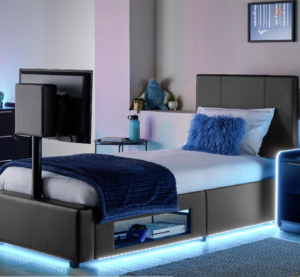 Choosing a comfortable single bed is crucial for achieving restful sleep and maintaining overall well-being. A good mattress plays a significant role in this process. The right mattress should provide adequate support for your body while conforming to your unique shape and sleeping position.
Choosing a comfortable single bed is crucial for achieving restful sleep and maintaining overall well-being. A good mattress plays a significant role in this process. The right mattress should provide adequate support for your body while conforming to your unique shape and sleeping position.
When selecting a single bed, consider factors such as mattress type, firmness level, and materials used. Memory foam, innerspring, latex, and hybrid mattresses each offer different benefits. Your preferred sleeping position, body weight, and any specific health concerns should guide your decision.
To find comfortable single beds, explore various options and test them out whenever possible. Pay attention to how your body feels when lying on different mattresses. A 10-15 minute trial can give you a good sense of whether a mattress suits your needs. Remember that personal preference plays a crucial role in mattress selection, so what works for one person may not be ideal for another.
Key Takeaways
- Match mattress firmness to your body type and sleeping position
- Consider different mattress materials and their unique benefits
- Test mattresses before purchasing to ensure comfort and support
Understanding Mattress Types and Materials
Mattress selection involves considering various types and materials. Each option offers unique characteristics that impact comfort, support, and durability.
Pros and Cons of Mattress Types
Memory foam mattresses contour to the body, providing excellent pressure relief. They excel at motion isolation but may retain heat. Innerspring mattresses offer bouncy support and good airflow. However, they can be noisy and may transfer motion.
Latex mattresses are naturally cooling and durable. They provide responsive support but can be heavy and expensive. Hybrid mattresses combine coils with foam or latex layers. This design aims to offer the benefits of multiple materials while minimizing drawbacks.
Latex and Memory Foam Differences
Latex foam comes from rubber tree sap. It’s more responsive and bouncy than memory foam. Latex also sleeps cooler and has natural antimicrobial properties. Memory foam, made from polyurethane, offers deeper contouring. It excels at pressure relief but may trap heat.
Both materials provide excellent support and durability. Latex tends to be more expensive but often lasts longer. Memory foam is generally more affordable and widely available in various densities.
Innerspring and Hybrid Structure
Innerspring mattresses use a coil support system. This core is typically topped with a comfort layer of fiber or foam. Coil types include Bonnell, offset, continuous wire, and pocketed coils. Each design affects the mattress’s feel, support, and motion transfer.
Hybrid mattresses combine an innerspring core with substantial foam or latex layers. The coil base provides support and bounce. The comfort layers add contouring and pressure relief. This structure aims to balance the benefits of different materials.
Evaluating Material Quality and Durability
High-density foams generally last longer and maintain their support better over time. For memory foam, look for densities of 4-5 lbs/ft³ or higher. Latex durability depends on whether it’s natural, synthetic, or blended.
Coil count and gauge affect innerspring quality. Higher coil counts often indicate better support. Thicker coils (lower gauge numbers) tend to be more durable. In hybrid mattresses, the quality of both the coils and comfort layers matters.
Consider certifications like CertiPUR-US for foam or GOLS for organic latex. These indicate adherence to quality and safety standards. Warranties can also hint at expected durability, with longer terms suggesting greater manufacturer confidence.
Selecting the Right Mattress for Your Needs
Choosing the right mattress is crucial for a comfortable and restful sleep. Several key factors come into play when selecting a mattress that suits your individual needs.
Considering Firmness and Support
Mattress firmness ranges from soft to extra firm. Body type and sleeping position influence the ideal firmness level. Lighter individuals often prefer softer mattresses, while heavier people may need firmer options for adequate support.
A 1-10 firmness scale helps compare mattresses:
- Soft: 3-5
- Medium: 5-7
- Firm: 7-9
Medium-firm mattresses (6-7) suit many sleepers. They offer a balance of comfort and support. Proper support maintains spinal alignment and reduces back pain.
Mattresses should contour to the body while providing enough resistance to prevent excessive sinking. This balance promotes healthy sleep posture and pressure relief.
Importance of Mattress Size and Space
Mattress size affects sleep quality and bedroom layout. Common single bed sizes include:
- Twin: 38″ x 75″
- Twin XL: 38″ x 80″
- Full: 54″ x 75″
Consider room dimensions and personal space needs. Taller individuals may prefer Twin XL for extra length. Full size offers more width for those who move frequently during sleep.
Adequate space allows for comfortable sleep and easy bed-making. It’s important to leave room for nightstands and walking space around the bed.
Special Requirements for Different Sleeping Positions
Sleep position impacts mattress choice:
Side sleepers: Softer mattresses (4-6 firmness) cushion hips and shoulders. They need pressure relief to prevent pain points.
Back sleepers: Medium to medium-firm mattresses (5-7 firmness) maintain neutral spine alignment. They should feel supported without sinking too deeply.
Stomach sleepers: Firmer mattresses (7-9 firmness) prevent hip sinking and maintain proper spinal alignment. Too soft a surface can cause lower back strain.
Combination sleepers benefit from medium firmness (5-7) for versatile support as they change positions.
Features for Temperature Regulation and Comfort
Temperature regulation enhances sleep quality. Cool-sleeping mattresses incorporate:
- Gel-infused foams
- Phase-change materials
- Breathable cover fabrics
Latex and innerspring mattresses naturally sleep cooler than traditional memory foam. Look for mattresses with air channels or open-cell structures for improved airflow.
Comfort layers made of memory foam or latex provide pressure relief. They conform to the body, reducing tossing and turning.
Edge support prevents sagging and extends the usable sleep surface. It’s particularly important for those who sit on the bed edge or sleep near the perimeter.
Motion isolation minimizes sleep disturbances for light sleepers. Memory foam and pocketed coils excel at reducing motion transfer.
Conclusion
Choosing a comfortable single bed requires careful consideration of key factors. Size, firmness, materials, and personal preferences all play crucial roles in finding the right mattress. A standard single bed measures approximately 38 inches wide by 75 inches long, providing adequate space for most individuals. Firmness levels should align with sleep position and body type to ensure proper support and comfort.






